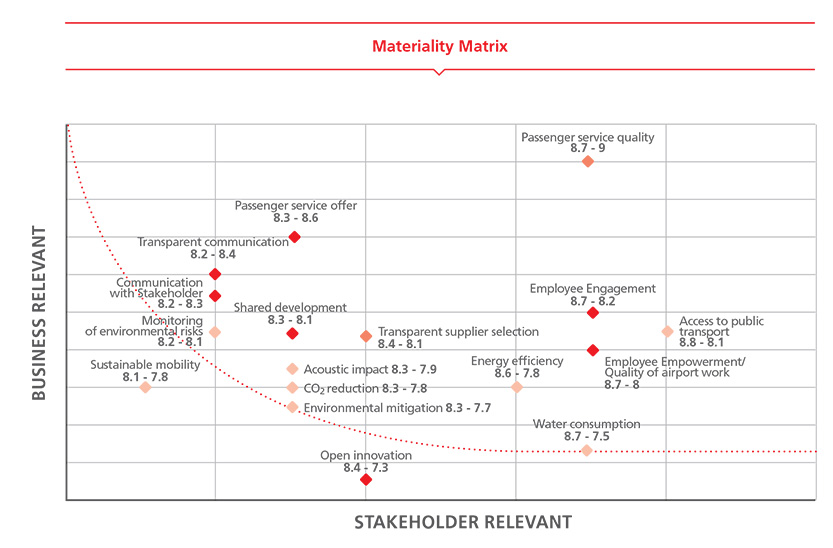How we created the materiality matrix
The starting point in our process of identifying the materiality matrix is represented by business challenges that define our medium-term horizon.
MEDIUM-TERM BUSINESS CHALLENGES
- Development of infrastructure capital
New Master Plans for Malpensa and Linate fundamental for the development strategy.
Infrastructure development of the two airports consistent with the long-term strategic vision. - Increased value generated by Aviation Business
Short-medium haul: further development of low-cost carriers.
Long-haul: development of new carriers and connections; development of incoming extra-EU traffic.
Cargo: consolidation of Malpensa as cargo hub. - Expansion of Non Aviation Business
Further diversification and improvement of the commercial offerings.
Continuous investment in improving service quality.
Become an airport operator of reference for digital innovation at a European level. - Operational efficiency
Improve productivity by continuing the streamlining initiated in the past years.
Significant reorganization plan, to be managed in a changed regulatory environment.
External costs: redefining purchasing conditions and volumes.
The items that characterize our relationship with our stakeholders were identified between 2012 and 2013, when we launched a number of initiatives to survey the "stakeholder voice".
Subsequently, the identified items were weighed through a survey conducted in 2013, involving a total of 111 subjects, of which 80 external stakeholders and 31 SEA managers (14 executives and 17 managers).
Overall, 45 items were submitted for sampling, distributed in four categories, corresponding to business challenges.
Both stakeholders and SEA management being surveyed assessed all items based on two dimensions of impact:
- importance according to their expectations;
- usefulness/consistency with SEA's business challenges.

Allocation of materiality issues to business challenges
| 1 - Development of infrastructure capital | 2 - Increase of value created by Aviation Business |
| Shared development | Passenger services quality |
| Communication with stakeholders | Accessibility of airports using public transport |
| Acoustic impact | Quality of airport work |
| Environmental mitigation measeres | |
| CO2 reduction | |
| Monitoring of environmental risks | |
| 3 - Expansion of Non-Aviation Business | 4 - Operational efficency |
| Widening in passenger service offering | Employee Empowerment |
| Employee Engagement | |
| Transparent supplier selection | |
| Energy savings | |
| Water consumption |